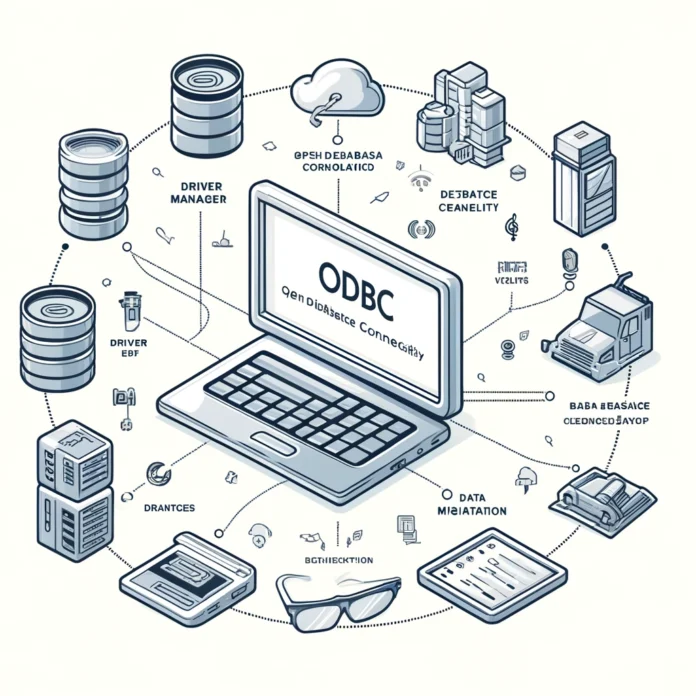Introduction
Open Database Connectivity (ODBC) is a widely-used standard API designed for accessing various Database Management Systems (DBMS). It was created to provide a universal way for applications to communicate with databases regardless of the database system or the operating system on which the application is running. ODBC enables seamless integration and interaction between applications and data sources, making it a critical component in the world of database connectivity.
Technical Specifications
ODBC is built on the foundation of the Call-Level Interface (CLI) specifications developed by the SQL Access Group. Its architecture includes several key components:
- Driver Manager: Acts as an intermediary between applications and ODBC drivers, managing communication and ensuring compatibility.
- ODBC Drivers: Specific to each database type, these drivers translate ODBC function calls into commands that the database can understand.
- Data Source Names (DSNs): Configurations that define how to connect to a database, including details like driver name, server address, database name, and authentication credentials.
Applications
ODBC is utilized across various industries and applications, including:
Business Intelligence
Tools like Tableau, Power BI, and QlikView use ODBC to connect to different data sources, enabling comprehensive data analysis and visualization.
Web Development
ODBC allows web applications to interact with databases, facilitating tasks like user authentication, data retrieval, and content management.
Data Migration
ODBC simplifies the process of transferring data between heterogeneous systems, ensuring data integrity and consistency.
Benefits
ODBC offers several advantages that make it a preferred choice for database connectivity:
Interoperability
ODBC works across multiple database systems and operating systems, providing a consistent way to access data regardless of the underlying technology.
Flexibility
ODBC supports various programming languages and development environments, making it versatile and adaptable to different application requirements.
Scalability
ODBC can handle the demands of both small and large-scale applications, ensuring reliable performance and efficient data access.
Challenges and Limitations
Despite its benefits, ODBC is not without its challenges:
Performance Overhead
The additional layer introduced by ODBC can sometimes lead to performance issues, particularly in high-throughput environments.
Complex Configuration
Setting up ODBC connections, including configuring DSNs and drivers, can be complex and time-consuming, requiring careful attention to detail.
Compatibility Issues
Not all databases support ODBC equally, and certain advanced features of a database might not be accessible through ODBC.
Latest Innovations
ODBC continues to evolve, incorporating new features and improvements:
Cloud Integration
Modern ODBC drivers offer enhanced support for cloud databases, enabling seamless connectivity to services like Amazon RDS, Microsoft Azure SQL Database, and Google Cloud SQL.
Improved Security
Recent updates have focused on strengthening encryption and authentication mechanisms, ensuring secure data transmission and access control.
Performance Enhancements
Optimized drivers and improved algorithms have led to better performance, reducing latency and increasing throughput.
Future Prospects
The future of ODBC looks promising, with several trends and developments on the horizon:
Increased Cloud Adoption
As more organizations move to cloud-based infrastructures, ODBC will play a crucial role in connecting applications to cloud-native databases.
AI Integration
ODBC will facilitate the integration of artificial intelligence and machine learning tools with databases, enabling more advanced data analysis and decision-making.
Enhanced Security
Ongoing improvements in data security will ensure that ODBC remains a trusted method for database connectivity in an increasingly security-conscious environment.
Comparative Analysis
When comparing ODBC to other database connectivity methods, several key differences and advantages emerge:
ODBC vs. JDBC
- Platform Dependency: ODBC is platform-independent, making it versatile across different systems. JDBC, on the other hand, is specific to the Java programming language.
- Performance: While JDBC may offer better performance for Java applications, ODBC’s versatility and broad support make it a preferred choice for many other scenarios.
User Guides or Tutorials
Setting Up ODBC on Windows
- Install ODBC Driver: Download and install the appropriate ODBC driver for your database from the database vendor’s website or a trusted source.
- Configure DSN: Open the ODBC Data Source Administrator, accessible via the Control Panel, and configure your DSN by specifying details such as the driver, server address, database name, and authentication credentials.
- Test Connection: Use the ODBC Data Source Administrator to test the connection, ensuring that the configuration is correct and the database is accessible.
Setting Up ODBC on Linux
- Install UnixODBC: Use your package manager to install the UnixODBC package, which provides the ODBC Driver Manager for Linux.
- Install ODBC Driver: Download and install the appropriate ODBC driver for your database. This might involve compiling the driver from source or using a pre-built package.
- Configure DSN: Edit the
odbc.iniandodbcinst.inifiles, typically located in/etcor the user’s home directory, to add your DSN settings. - Test Connection: Use the
isqlcommand-line utility to test your ODBC connection and verify that the database is accessible.
Conclusion
ODBC remains a vital technology for database connectivity, offering a flexible, interoperable, and scalable solution for accessing diverse data sources. Its ability to adapt to new challenges and incorporate advancements ensures its relevance in the ever-evolving landscape of data management.
FAQs
What is ODBC?
ODBC stands for Open Database Connectivity, a standard API for accessing DBMS.
Why use ODBC?
ODBC allows applications to access data from various DBMSs without requiring database-specific code, providing flexibility and interoperability.
How to configure ODBC on Windows?
Install the ODBC driver, configure a DSN using the ODBC Data Source Administrator, and test the connection to ensure proper setup.
What are the challenges with ODBC?
Common challenges include performance overhead, complex configuration, and compatibility issues with certain databases.
What is the future of ODBC?
Future prospects for ODBC include better cloud integration, AI integration, and continuous enhancements in security to meet evolving needs.





